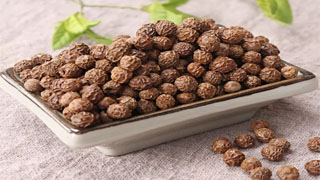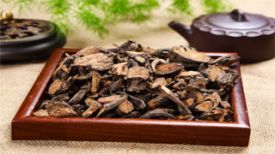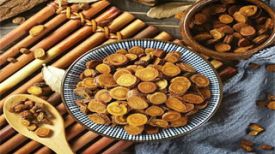
1. Alias
Peng'er fruit, Tongma pea, Fengyan fruit, Honghua fruit.
2. Plant morphology
Deciduous tree, 16 meters high, with green and smooth bark. Leaves alternate, 3-5 palmate deeply lobed, 15-30 cm long, 11-20 cm wide, base heart-shaped, lobes triangular, apex gradually pointed, both sides hairless or slightly pubescent, veins palmate; The petiole and leaf blade are nearly equal in length. Apiform inflorescence; Flowers unisexual, pale yellow green; Sepals 5, strip-shaped, about 8 millimeters long, densely covered with light yellow short hairs on the outside; The stem and flower are nearly equal in length; The stamen column in male flowers is about the same length as the sepals, with 15 anthers clustered at the top of the stamen column; The ovary stalk of female flowers is well-developed, the carpel is 5, and the base is separated. The follicles are membranous, have stems, and crack into leaf like shapes when mature. They are 6-11 centimeters long and 1.5-2.5 centimeters wide, with 2-4 seeds per follicle. The seed is spherical in shape, with wrinkles on the surface, and has a diameter of about 7 millimeters. The flowering period is from June to July, and the fruiting period is from August to November.
3. Origin distribution
Most of them are artificially cultivated. Distributed throughout the north and south of China.
4. Harvesting and processing
Harvested in summer and autumn, fresh or sun dried.
5. Characteristics of medicinal herbs
Spherical in shape, resembling peas. The surface is light green to yellow brown, with a slight luster and obvious raised mesh wrinkles. Lightweight and hard, the outer layer of the seed coat is brittle and prone to breakage, while the inner layer is tough. After peeling off the seed coat, several layers of pale red outer endosperm can be seen, with thick pale yellow inner endosperm inside. The cotyledons are thin and large, closely attached to the inner milk, and the embryonic root is located at the smaller end. The odor is mild.
6. Sexual Taste Returning to the Classics
Flat in nature, sweet in taste. Returning to the Heart Meridian, Lung Meridian, and Kidney Meridian.
7. Effect and Function
Promote qi circulation, invigorate the spleen, digest food, and stop bleeding. It belongs to the category of digestive medicine.
8. Clinical application
Dosage: 5-10 grams; Or at the end of the study, 2-3 grams. For external use: Apply in moderation, with a moisturizing powder. Used to treat spleen deficiency, qi stagnation, indigestion, stomach pain, diarrhea, and nosebleeds. In addition, it can also treat conditions such as early white hair and pediatric oral ulcers.
9. Pharmacological research
Intravenous injection of total alkaloids from seeds of wutong tree into anesthetized rabbits and cats can rapidly decrease blood pressure, but not for a long time, and at the same time slow down heart rate. Decoction can shorten the duration of traumatic bleeding in rats.
10. Chemical composition
Containing 39.69% fatty oil, components such as malic acid, malic acid, and caffeine were isolated from the oil.
11. Usage taboos
It is not suitable for people with cough and phlegm, or those with ear diseases.
12. Compatibility prescription
① Treatment of abdominal pain and diarrhea due to food injury: fried wutong seeds with burnt powder. Take 3 grams each. (Handbook of Commonly Used Chinese Herbal Medicines in Guangzhou Army)
② Treatment of abdominal pain and diarrhea: 15g of wutong seeds (fried), 12g of green rattan incense. It is a fine powder. Take 3 grams per dose, with hot water included. (Sichuan Journal of Traditional Chinese Medicine, 1979)
③ Treatment of hernia: stir fry wutong seeds until fragrant, and eat them after shelling. (Guizhou Province Traditional Chinese Medicine Experience Secret Formula)
④ Treatment of white hair: 9 grams of wutong seeds, 15 grams of polygonum multiflorum, 9 grams of black sesame seeds, 15 grams of rehmannia glutinosa. Boil it in water. (Shandong Herbal Medicine Handbook)
⊙ The content of the article is for clinical reference only. Non TCM professionals are not allowed to test drugs.


